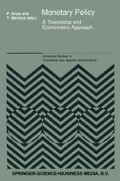Abstract
Recent studies have applied disequilibrium models to business loans markets. Laffont and Garcia (1977) analysed the supply and demand for business loans by chartered banks in Canada using monthly data, and concluded to “the necessity of using disequilibrium methods”. Sealey (1979) studied the commercial loan market in the United States with a disequilibrium model, using quarterly data. He concluded that “the degree of disequilibrium in the US loans market ... is considerably greater than that found by Laffont and Garcia for the business loan market in Canada”.
Access this chapter
Tax calculation will be finalised at checkout
Purchases are for personal use only
Preview
Unable to display preview. Download preview PDF.
References
Bowden, R.J. (1978), The Econometrics of Disequilibrium, North—Holland, Amsterdam.
Dagenais, M.G. (1980), “Specification and Estimation of a Dynamic Dis—equilibrium Model”, Economics Letters, 5, pp. 323–28.
Dagenais, M.G. and M. Dagenais (1982), “Algorithme de sélection sous constraintes d’un sous—ensemble d’éléments homogènes”, Annales des sciences mathématiques du Québec, VI, 1, pp. 43–51.
Dagenais, M.G. and R. Laferrière (1983), “L’évaluation du biais d’estimation des termes constants, dans un modèle de déséquilibre dynamique”, Cahier no. 8334, Département de sciences économiques, Université de Montréal.
Dagenais, M.G. (1984), “A Short—Term Disequilibrium Model with Dynamic Spill—Over Effects, for Business Loans”, Cahier no. 8436, Département de sciences économiques, Université de Montréal.
Gilbert, A. (1980), “Lagged Reserve Requirements: Implications for Monetary Control and Bank Reserve Management”, Federal Reserve Bank of St. Louis, pp. 7–20.
Ito, T. and K. Ueda (1981), “Tests of the Equilibrium Hypothesis in Disequilibrium Econometrics: An International Comparison of Credit Rationing”, International Economic Review, 22, 3, pp. 691–708.
Laffont, J—J. and R. Garcia (1977), “Disequilibrium Econometrics for Business Loans”, Econometrica, 54, pp. 1187–1204.
Liviatan, N. (1963), “Consistent Estimation of Distributed Lags”, International Economic Review, 4, pp. 44–52.
Melitz, W. and M. Pardue (1973), “The Demand and Supply of Commercial Bank Loans”, Journal of Money, Credit and Banking, pp. 669–92.
Oberhofer, W. and J. Kmenta (1974), “A General Procedure for Obtaining Maximum Likelihood Estimates in Generalized Regression Models”, Econometrica, 42, pp. 579–90.
Sealy, C.W. Jr. (1979), “Credit Rationing in the Commercial Loan Market: Estimates of a Structural Model under Conditions of Disequilibrium”, Journal of Finance, 34, pp. 689–702.
Wallis, K.F. (1967), “Lagged Dependent Variables and Serially Correlated Errors: A Reappraisal of Three Pass Least—Squares”, Review of Economics and Statistics, 49, pp. 555–67.
White, H. (1980), “A Heteroskedasticity—Consistent Covariance Matrix Estimator and a Direct Test for Heteroskedasticity”, Econometrica, 48, 4, pp. 817–38.
Author information
Authors and Affiliations
Editor information
Rights and permissions
Copyright information
© 1990 Springer Science+Business Media Dordrecht
About this chapter
Cite this chapter
Dagenais, M.G. (1990). A Short Term Disequilibrium Model with Carry-Over, for US Business Loans. In: Artus, P., Barroux, Y. (eds) Monetary Policy. Advanced Studies in Theoretical and Applied Econometrics, vol 19. Springer, Dordrecht. https://doi.org/10.1007/978-94-015-7852-3_9
Download citation
DOI: https://doi.org/10.1007/978-94-015-7852-3_9
Publisher Name: Springer, Dordrecht
Print ISBN: 978-90-481-4062-6
Online ISBN: 978-94-015-7852-3
eBook Packages: Springer Book Archive

